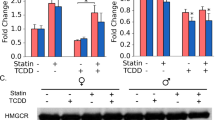Summary
Two rat liver cytosolic aldehyde dehydrogenases, ALDH1 and ALDH3c, are of particular interest because they are inducible by different classes of xenobiotics. ALDH1 is mainly increased by phenobarbital-type inducers; polycyclic aromatic hydrocarbons (PAHs), such as 3-methylcholanthrene (3MC), increase ALDH3c enzyme activity in all rat species currently tested. In addition, ALDH3c has been found to reflect the subfamily CYP1A of cytochrome P-450, as well as other enzymes functionally related to the aryl hydrocarbon receptor (the “Ah-receptor enzyme battery”), which is activated by the same type of inducers. In the present study we investigated whether the induction of ALDH3c might be connected with a chemically produced aseptic inflammation of the hepatocyte. To answer this question, we examined the relationship between the induction of ALDH3c by 3MC and the arachidonic acid cascade. Different non-steroid anti-inflammatory drugs (NSAIDs) were tested in combination with 3MC and in post-treatment. The 3MC-induced ALDH3c activity was significantly diminished by the co-administered anti-inflammatory agents. Two microsomal enzyme activities (ethoxyresorufin-O-deethylase EROD; aryl-hydrocarbon-hydroxylase, AHH) were also decreased. Similar results were obtained with NSAIDs administered to animals pre-treated with 3MC, as far as the ALDH3c activity was concerned, but not for the microsomal enzyme activity (EROD and AHH). In conclusion, the induciton of ALDH3c, after PAH treatment, may be related to an aseptic inflammation of the hepatocytes. This effect is reduced by commonly used steroid and non-steroid anti-inflammatory drugs, and although the mechanism of inhibition has not yet been elucidated, it appears likely that ALDH3c and CYP1A activities are associated with the “acute phase” response.
Similar content being viewed by others
References
Marselos M., Vasiliou V. (1991): Effect of various chemicals on the aldehyde dehydrogenase activity of the rat liver cytosol. Chem.-Biol. Interact., 79, 79–89.
Pappas P., Vasiliou V., Karageorgou M., Stephanou P., Marselos M. (1995): Studies on the induction of rat class 3 aldehyde dehydrogenase. Adv. Exp. Med. Biol., 372, 143–149.
Dunn T.J., Lindahl R., Pitot H.C. (1988): Differential gene expression to 2,3,7,8-tetrachlorodibenzo-p-dioxin (TCDD). Non-coordinate regulation of a TCDD-induced aldehyde dehydrogenase and cytochrome P-450c in the rat. J. Biol. Chem., 263, 10878–10886.
Vasiliou V., Marselos M. (1989a): Tissue distribution of inducible aldehyde dehydrogenase activity in the rat after treatment with phenobartial and methylcholanthrene. Pharmacol. Toxicol., 64, 39–42.
Pappas P., Stephanou P., Vasiliou V., Karamanakos P., Marselos M. (1997): Ontogenesis and expression of ALDH activity in the skin and the eye of the rat. Adv. Exp. Med. Biol., 414, 73–80.
Nebert D.W., Puga A., Vasiliou V. (1993): Role of the Ah receptor and the dioxin-inducible [Ah] gene battery in toxicity, cancer and in signal transduction. Ann. N. Y. Acad. Sci., 685, 624–640.
Vasiliou V., Puga A., Chang C.-Y., Tabor M.W., Nebert D.W. (1995a): Interaction between the Ah receptor and proteins binding to the AP-1-like electrophile response element (EpRE) during murine phase II [Ah] battery gene expression. Biochem. Pharmacol., 50, 2057–2068.
Burke M.B., Mayer R.T. (1975): Inherent specificities of purified cytochromes P-450 and P-448 toward biphenyl hydroxylation and ethoxyresorufin deethylation. Drug Metab. Dispos., 3, 245–253.
Rahimtula A.D., Zachariah P.K., O’Brien P.J. (1977): The effects of antioxidants on the metabolism and mutagenicity of benzo[a]pyrene in vitro. Biochem. J., 164, 473–475.
Lowry O.H., Rosebrough N.J., Farr A.L., Randall R.J. (1951): Protein measurement with Folin phenol reagent. J. Biol. Chem., 193, 265–275.
Vasiliou V., Marselos M. (1989b): Changes in the inducibility of a hepatic aldehyde dehydrogenase by various effectors. Arch. Toxicol., 63, 221–225.
Flower R.J. (1988): Lipocortin and the mechanism of action of glucocorticoids. Br. J. Pharmacol., 94, 987–1015.
Sherratt G.J., Bnet D.E., Linder M.W., Prough R.A. (1989): Potentiation of 3-methylcholanthrene induction of rat hepatic cytochrome P450IA1 by dexamethasone in vivo. J. Pharmacol. Exp. Ther., 249, 667–672.
Vasiliou V., Reuter S.F., Kozak C.A., Nebert D.W. (1995b): Mouse class 3 aldehyde dehydrogenases. Adv. Exp. Med. Biol., 372, 143–150.
Alam T., An M.R., Papaconstantinou J. (1992): Differential expression of three C/EBP isoforms in multiple tissues during the acute phase response. J. Biol. Chem., 267, 5021–5024.
Author information
Authors and Affiliations
Rights and permissions
About this article
Cite this article
Pappas, P., Stephanou, P., Vasiliou, V. et al. Anti-inflammatory agents and inducibility of hepatic drug metabolism. Eur. J. Drug Metab. Pharmacokinet. 23, 457–460 (1998). https://doi.org/10.1007/BF03189995
Issue Date:
DOI: https://doi.org/10.1007/BF03189995




